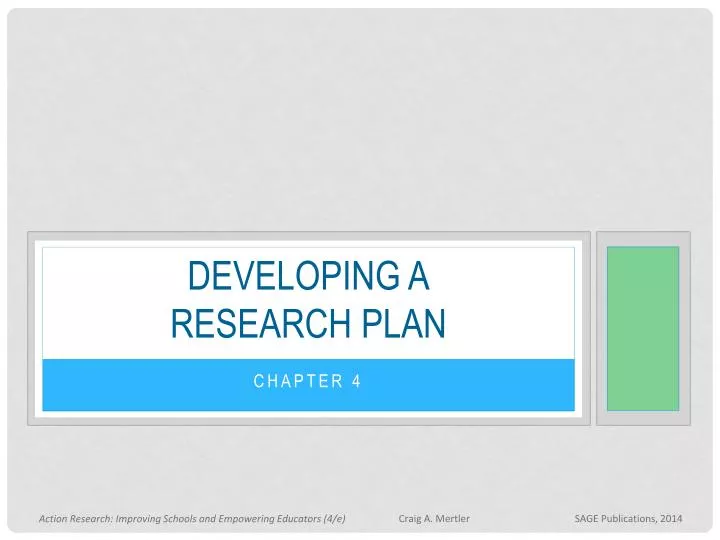

Developing a research plan
Apr 01, 2019
250 likes | 580 Views
Developing a research plan. Chapter 4. Craig A. Mertler SAGE Publications, 2014. Action Research: Improving Schools and Empowering Educators (4/e). Research Questions. First, decide whether you plan to use a qualitative or quantitative approach and data
Share Presentation
- informed consent form
- data collection
- methods design
- comparative designs
- important characteristics
- posttest control group design

Presentation Transcript
Developing aresearch plan Chapter 4 Craig A. Mertler SAGE Publications, 2014 Action Research: Improving Schools and Empowering Educators (4/e)
Research Questions • First, decide whether you plan to use a qualitative or quantitative approach and data • Decision-making table (Table 4.1) can help • Research question—fundamental question inherent in research topic under investigation • Purpose is to guide the study; goal is to be able to answer the question at the end of the study • Can guide both qualitative and quantitative studies • Review examples
Research Questions • Important characteristics of research questions: • Qualitative questions should be more open-ended than quantitative questions • Questions should not be stated in a manner that assumes an answer even before data are collected • Ensure the question is neither too broad nor too specific • Questions should be based in the body of literature on the topic • Must be answerable (based on data) • Must follow ethical practices • Should be both important and feasible to answer
Research Questions • Hypothesis—tentative, but intelligent and informed, guess as to outcome of study (made before study begins) • Typically, less appropriate for action research studies • Used only when design calls for use of inferential statistical analysis (i.e., some, but not all, quantitative studies) • Three types of hypotheses: • Null hypothesis—no effect, change, or relationship • Nondirectional research hypothesis—some sort of effect (etc.), but no prediction of direction of effect • Directional research hypothesis—some effect with direction specified
Research Questions • Review examples • Important characteristics of hypotheses: • Hypotheses cannot be proven • Data can only support a stated hypothesis • Research hypotheses are supported only when analysis of data statistically show that the null hypothesis is likely not true
Basic Research Designs • Qualitative “research designs”: • Misnomer in qualitative research; perhaps “research plans” • Questions tend to be more open-ended (might even emerge during the study) • More difficult to specify methods at the outset • Several approaches exist: • Case studies—particular individual, event, or program is studied • Ethnographies—in-depth study of a group • Phenomenological studies—studies of individual perceptions of a particular situation
Basic Research Designs • Specific qualitative approaches: • Case studies • Detailed study of a single setting, subject, or a particular event • Begin with a broad approach to topic; as study progresses, study becomes more focused • Observational case studies: • Most common type; involve study of particular organization or aspect of the organization • Requirement to select focus within the setting
Basic Research Designs • Specific qualitative approaches (cont’d.): • Observational studies: • Similar, but focus is more broad • Researcher becomes integral part of the study • Participant observation is key • Participant-observer continuum:
Basic Research Designs • Specific qualitative approaches (cont’d.): • Constant comparative method—design for studies involving multiple data sources, where analysis begins early in data collection, continues throughout collection, and is nearly completed by the end of data collection • Data collection actually begins prior to specific topic or focus being identified • Cyclical process (good fit with action research)
Basic Research Designs • Quantitative research designs: • Require the use of quantitative methods and data • Four broad categories of quantitative designs appropriate for teacher-led action research: • Descriptive designs • Correlational designs • Group comparison designs • Single-subject designs
Basic Research Designs • Quantitative research designs (cont’d.): • Descriptive designs—purpose is to describe and make interpretations of current status (i.e., as it exists) of individuals, objects, conditions, or events • Observational research • Focus is on a specific variable (not to be confused with qualitative counterpart) • Observations of the single variable are made • Survey research • Acquiring information from representative individuals • A “snapshot”approach to studying many variables
Basic Research Designs • Quantitative research designs (cont’d.): • Correlational designs—purpose is to measure and describe statistical relationship between two or more variables • Requires calculation of correlation coefficients • Reports strength and direction of relationship • Typically range from -1.00 to +1.00 • Interpretation of positive and negative coefficients (direction; indicated by + or -) • Interpretation of numerical value (strength; indicated by number) • Remember: Correlation ≠ Causation
Basic Research Designs • Quantitative research designs (cont’d.): • Group comparison designs—attempt to investigate cause-and-effect relationships by comparing two or more groups that differ on some characteristic • Only one approach will show if one variable can cause another (experimental) • Causal-comparative designs: • Explore reasons behind existing differences between groups • Ex post facto = “after the fact” • Presumed cause has already occurred (prior to study)
Basic Research Designs • Quantitative research designs (cont’d.): • Pre-experimental designs: • “Preliminary” experimental designs • Incorporate only some of critical aspects of experimental designs • One-shot case study:
Basic Research Designs • Quantitative research designs (cont’d.): • Pre-experimental designs: • One-group pretest-posttest design:
Basic Research Designs • Quantitative research designs (cont’d.): • Quasi-experimental designs: • Come closest to experimental designs; only missing component is no random assignment • Pretest-posttest control group design:
Basic Research Designs • Mixed-methods research designs • Explanatory mixed-methods designs:
Basic Research Designs • Mixed-methods research designs • Exploratory mixed-methods designs:
Basic Research Designs • Mixed-methods research designs • Triangulation mixed-methods designs:
Research planning template • Action Research Design Development
Ethical Considerations • Must be incorporated into development of a research plan • Permissions from students, parents, teachers, others • May require formal permission—HSRBs or IRBs • NIH human subjects training (http://phrp.nihtraining.com) • Consent and assent • Informed consent form (see Figure 4.5) • Guiding principles to be included: • Principle of accurate disclosure • Principle of beneficence • Principle of honesty • Principle of importance
Action research checklist 4 Developing a Research Plan for Conducting Action Research ☐ Using Table 4.1 as a guide, determine if a qualitative, quantitative, or mixed-methods design would be more appropriate for your action research study. ☐ Develop one or two research questions to guide your study. ☐ Depending on your selection of a qualitative, quantitative, or mixed-methods design, weigh the advantages and limitations of specific research designs. ☐ Determine the most appropriate design for conducting your action research study. ☐ Evaluate, and address, any potential ethical issues in your study. ☐ If appropriate, develop consent and assent forms. ☐ Develop a reasonable timeline for conducting your study.
- More by User

Developing a Recall Plan
Every Processor Should. Develop a recall planOrganization structure for product withdrawals quickly and effectivelyDevelopment of a recall team. Recall Plan. Organization StructureIdentification of Information NeedsDistributionProductionLegal CounselPublic Relations. Recall Plan. Technical In
446 views • 12 slides

Developing a Board Plan
286 views • 18 slides
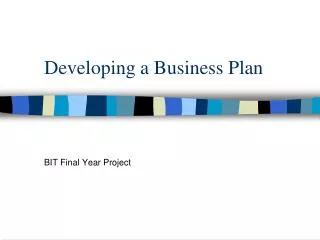
Developing a Business Plan
Developing a Business Plan. BIT Final Year Project. Learning Outcomes. Understand the objectives of the business planning process for a start up venture. Gain an insight into how to write such a business plan.
839 views • 54 slides

Developing a Business Plan. Presentation to TPP November 2000 D.B. Matias. Overview of Last Discussion. Know your audience Who is your reader What is their risk profile (risk/reward analysis) Why would they invest in you (synergies) Know your forms of funding Private equity
365 views • 12 slides

Developing a business plan
Developing a business plan. What is a Business Plan?. A written document that describes all the steps necessary for opening and operating a successful business. What Does a Business Plan Do?.
257 views • 6 slides

Developing a Marketing Plan
Developing a Marketing Plan. Designer desk accessories. INTRODUCTION. Gloria’s Gifts is a small business specialising in office accessories especially for women.
254 views • 11 slides

Developing a Marketing Plan. Chapter 11.3 and 11.4. Know Where You are Headed. A marketing plan is a written component of the strategic plan that addresses how the company will carry out the key marketing functions . A marketing plan can be simple or detailed.
431 views • 15 slides
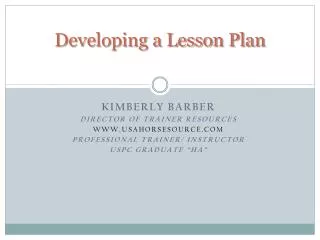

Developing a Lesson Plan
Developing a Lesson Plan. Kimberly Barber Director of Trainer Resources www.USAHorseSource.com Professional Trainer/ Instructor USPC Graduate “HA”. Welcome to Today’s Presentation. Discussion on what you look for in a trainer / lesson Why use a lesson plan Developing a lesson plan
583 views • 19 slides
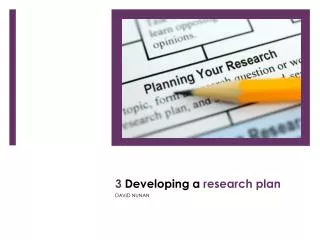
3 Developing a research plan
3 Developing a research plan. DAVID NUNAN. The messiness of the research process.
268 views • 13 slides

Developing a Trading plan
Developing a Trading plan . By Stefan Juriansz Markets Never Lie ( P vt ) Ltd . What makes a successful trader . The most important element of successful trading is having a trading system that fits your personality Jack Schwagger Eat, Shit and drink Trading
847 views • 9 slides

Appendix D. Developing a Business Plan. What is a Business Plan?. A well-written business plan serves two key functions: It organizes the business and validates its central idea It summarizes the business and its strategy to obtain funding from lenders and investors
291 views • 5 slides

Developing a Sign Plan
Developing a Sign Plan. Determine Scope. Will the sign plan encompass: An entire Field Office Area ? An ACEC? WSA? Campground?. Research and Data Collection. Review the Resource Management Plan Complete a Sign Inventory Produce a Map. Consider Relevant Variables for the site:
275 views • 15 slides

Developing a Business Plan. A Step by Step G uide. This Material Developed By Joseph Bonelli from the University of Connecticut and Jon Jaffe from Farm Credit East. “This institution is an equal opportunity provider.”. What is a Business Plan?.
976 views • 64 slides

Developing a Marketing Plan. Use a good Marketing Plan to guide the strategic and tactical direction of your business. Learning Objectives. At the end of this module, you will be able to: Identify the importance and the need for a good Marketing Plan.
556 views • 21 slides

Developing a Marketing Plan. Develop a strategic marketing plan to successfully grow your business and increase profits. Learning Objectives. At the end of this module, you will be able to: Understand the importance and need for a good marketing plan.
645 views • 25 slides
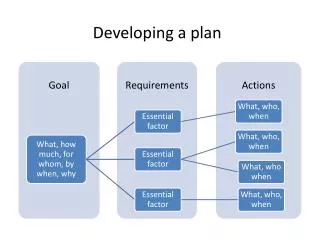
Developing a plan
Developing a plan. Developing a plan.
145 views • 2 slides

Developing a Project Plan
Chapter 6. Developing a Project Plan. Luck favors to a prepared mind….. Louis Pasteur. Developing a Project Plan. The biggest and important part of a project plan is establishing the project network. Project Network.
399 views • 22 slides

Developing a Business Plan. What is a Business Plan?. A business plan is a document that outlines your plan for initiating and operating a business. Why Create a Business Plan?. It provides a path to follow
328 views • 8 slides

Developing your Research Plan
Developing your Research Plan. for FemNorthNet Community Case Studies. Developing your research plan. Your research plan will tell the story of what you plan to do over the next four years: The research questions you want to explore How you will carry out the research and
396 views • 17 slides
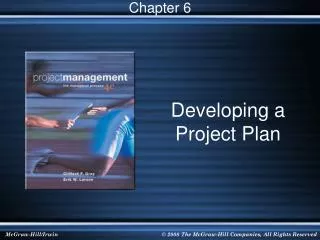
Chapter 6. Developing a Project Plan. Developing the Project Plan. The Project Network A flow chart that graphically depicts the sequence, interdependencies, and start and finish times of the project job plan of activities that is the critical path through the network
1.25k views • 51 slides

Developing A Business Plan
Developing A Business Plan. Understand the Audience Functions of a Business Plan What Do Investors Look For? Tell A Story The Bottom Line Topics A Business Plan Should Not: Gaffs to Avoid Remember:. Understand the Audience. Managing Other People’s Money Pension Funds
298 views • 10 slides

Developing a Marketing Plan. John D. Lawrence, Ph.D. Extension Livestock Economist Iowa State University. Definitions. Market What, When, Where, Who Plan Forethought Written Decisions Implementation. Why develop a marketing plan. Internal audience Support business goals
331 views • 18 slides

IMAGES
VIDEO